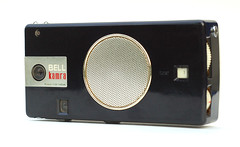Difference between revisions of "Ramera"
Rebollo fr (talk | contribs) (description of the camera, biblio, links) |
Rebollo fr (talk | contribs) m (biblio detail) |
||
| Line 2: | Line 2: | ||
|image=[http://www.flickr.com/photos/kratz/1348786994/in/pool-camerapedia/ http://farm2.static.flickr.com/1386/1348786994_b1f138de9a_m_d.jpg]<br>''<small>Picture by John Kratz. {{creative commons}}</small>'' | |image=[http://www.flickr.com/photos/kratz/1348786994/in/pool-camerapedia/ http://farm2.static.flickr.com/1386/1348786994_b1f138de9a_m_d.jpg]<br>''<small>Picture by John Kratz. {{creative commons}}</small>'' | ||
}} | }} | ||
| − | {{ | + | {{WIP}} |
The '''Ramera''' is a fancy combination of a transistor radio and a 16mm camera, made by [[Kowa]] in 1959–60. It was also sold by [[Bell]] under the name '''Bell Kamra'''. The camera part was sold alone in limited quantities as the '''Bell 16'''. | The '''Ramera''' is a fancy combination of a transistor radio and a 16mm camera, made by [[Kowa]] in 1959–60. It was also sold by [[Bell]] under the name '''Bell Kamra'''. The camera part was sold alone in limited quantities as the '''Bell 16'''. | ||
| Line 18: | Line 18: | ||
* {{McKeown12}} Pp.123 and 548. | * {{McKeown12}} Pp.123 and 548. | ||
* {{Pritchard}} P.119. | * {{Pritchard}} P.119. | ||
| − | * {{Zukan}} Items | + | * {{Zukan}} Items 5015–6 and 5119. |
== Links == | == Links == | ||
Revision as of 13:18, 21 September 2008
The Ramera is a fancy combination of a transistor radio and a 16mm camera, made by Kowa in 1959–60. It was also sold by Bell under the name Bell Kamra. The camera part was sold alone in limited quantities as the Bell 16.
Description of the camera alone
The Bell 16 is the camera part of the Ramera. It is rarely found alone, and the only example observed so far is pictured in Sugiyama.[1]
The camera takes 10×14mm pictures on 16mm film in Minolta 16 cassettes.[2] When sold alone, it has the shape of a matchbox, with the lens on the larger side and satin metal finish overall. The viewfinder is at the bottom right, as seen by the photographer holding the camera horizontally. The film is advanced by pulling a bar on the right, next to the shutter release. The exposure counter, visible in a small window next to the viewfinder eyepiece, is advanced at the same time. There are two dials at the top, near the front edge, controlling the aperture on the left (from 3.5 to 11) and the shutter speed on the right (B, 50, 100, 200). The rest of the top plate is hinged to the left for film loading, and is opened by a button next to the shutter release. The camera is synchronized for flash, via a PC connection on the front plate.
Combined radio and camera
The Ramera and Bell Kamra contain the camera described above, stripped of its metal casing, and a transistor radio combined in a plastic shell. The camera part is inserted at the right end of the item, and is oriented vertically.
Bibliography
- Asahi Camera (アサヒカメラ) editorial staff. Shōwa 10–40nen kōkoku ni miru kokusan kamera no rekishi (昭和10–40年広告にみる国産カメラの歴史, Japanese camera history as seen in advertisements, 1935–1965). Tokyo: Asahi Shinbunsha, 1994. ISBN 4-02-330312-7. Item 1750.
- Lewis, Gordon, ed. The History of the Japanese Camera. Rochester, N.Y.: George Eastman House, International Museum of Photography & Film, 1991. ISBN 0-935398-17-1 (paper), 0-935398-16-3 (hard). P.103.
- McKeown, James M. and Joan C. McKeown's Price Guide to Antique and Classic Cameras, 12th Edition, 2005-2006. USA, Centennial Photo Service, 2004. ISBN 0-931838-40-1 (hardcover). ISBN 0-931838-41-X (softcover). Pp.123 and 548.
- Pritchard, Michael and St. Denny, Douglas. Spy Cameras — A century of detective and subminiature cameras. London: Classic Collection Publications, 1993. ISBN 1-874485-00-3. P.119.
- Sugiyama, Kōichi (杉山浩一); Naoi, Hiroaki (直井浩明); Bullock, John R. The Collector's Guide to Japanese Cameras. 国産カメラ図鑑 (Kokusan kamera zukan). Tokyo: Asahi Sonorama, 1985. ISBN 4-257-03187-5. Items 5015–6 and 5119.
Links
In English:
- Ramera, Bell Kamra and Bell 16 at Submin.com
- Ramera at Fifties Radio (click on the arrows to navigate)
- Ramera at Cameras Downunder
- Ramera, lot no.658 of auction no.11 (26 May 2007) by Westlicht Photographica Auction
- Ramera in Moshe Bar-El's camera collection
- Bell Kamra in the Western Photographic Historical Society website
- Ramera and Bell Kamra among 16mm film cameras at Subclub.org
In Spanish:
In Japanese:
